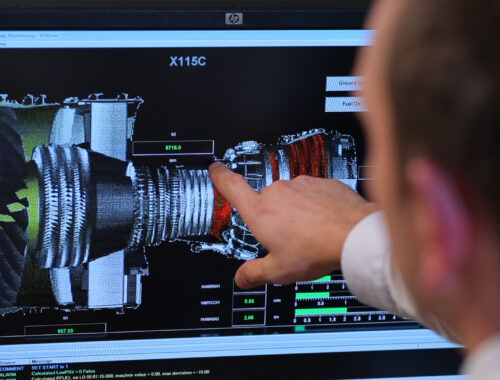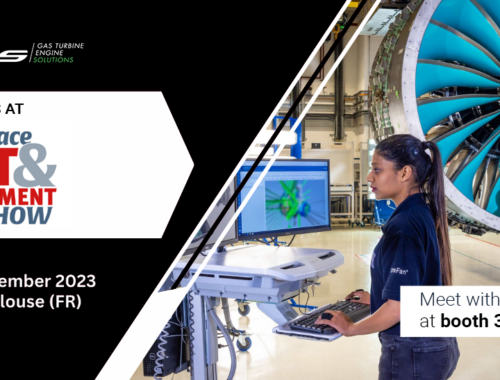FORE! MDS’ Golf Ball Design Minimizes Engine Noise
“What is that big golf ball doing eating that engine?!” One of the more intriguing pieces of test equipment that always generates questions when anyone sees a picture of one is the informally named “golf ball” or Inlet Control Device. MDS has a proven design for this odd-looking test equipment that is supplied to aerospace gas turbine engine developers.
Background
Certifying large civil gas turbine engines to increasingly stringent noise requirements is an important part of today’s engine development. Periodically the International Civil Aviation Organization, ICAO, updates the requirements for allowable aircraft noise levels to ever quieter targets. Certification of new large civil aircraft with modern turbofan gas turbine engines by national or regional authorities typically follows these international standards. The latest targets are called the “Stage 4” and are the latest in ever more demanding noise level requirements.
Gas turbine engines contribute a large part of the noise characteristics of an aircraft. The most significant time of operation is during landing and takeoff during which time the engines, landing gear, doors and fairings, and control surfaces including flaps all generate noise. It is thus very important for the engine manufacturers to minimize their engine noise signatures. They must be able to measure its noise performance and certify this during engine static tests prior to flight operations.
Outdoor Engine Static Testing
Testing a gas turbine engine outdoors has many advantages and uses during the developmental as well as certification phases. Specifically for noise certification of the engine, a large open arena and array of microphones for far field measurements are required. These microphones are typically arranged in an arc approximately 50m from the engine outdoor test stand and ideally any external sources of noise and reflections are minimized. The engine is then tested under conditions that accurately reproduce engine operations, especially takeoff and landing configuration, to measure and characterize the noise signature.
One unexpected aspect of outdoor static testing is that the noise characteristic of engines running in free air is higher than what is measured when on-wing in the air. It has been demonstrated that the greatest contributor to the engine noise, the fan blades, produce higher absolute noise levels on an outdoor static test stand compared to in-flight. This static test noise level is higher with the new technology higher bypass engines. It has also been determined that turbulent air reaching the fan inlet causes enough negative interaction to significantly affect the noise signature and speed stability of an engine – very undesirable effects for the engine developer trying to accurately measure the noise signature. This turbulent air is the result of unavoidable crosswinds experienced during an engine test run.
Inlet Control Device
Gas turbine engine manufacturers occasionally require a new Inlet Control Device (ICD) to meet testing needs for new engine ranges or outdoor test stands. MDS has supplied a number of these ICDs and understands the technology behind the sizing and operation of this very specialized test hardware. MDS can also customize the device to meet additional technical requirements specific to each application.
The ICD helps to control the turbulent flow of air into the engine bellmouth by smoothing and normalizing the flow in front and around the engine. This is accomplished by having the air flow through a spherical screen that is supported by a geodesic structure dome several metres in diameter. The incoming air enters through numerous holes of a steel plate and then is straightened by an aluminum honeycomb panel several centimetres thick. The air being sucked into the engine inlet is then able to flow nicely and without turbulence.
The ICD is designed to work in winds of up to 5m/s which will allow the user to test in a variety of wind conditions while not losing too many testing opportunities. The ICD allows winds from numerous directions: side, front and rear.
Inlet Velocity Vectors ICD with Wind At 5m/s
Each device is sized for the expected range of similar sized engines; at a certain point a separate ICD may be required if the engine difference is too large. The size is a function of the engine bellmouth inlet diameter and how it fits around the fixed test stand. The structure used to support the dome is sealed to the engine body with a flexible sail cloth that also prevents unwanted airflow from the rear of the engine reaching the bellmouth inlet.
Now that the airflow to the engine has been controlled to improve the inlet conditions and thus better represent in flight operation, it must be remembered that the prime goal is to be able to perform noise characterization testing for the purposes of certification. In order to do this, MDS has designed the ICD to also minimize the acoustic blockages: the perforated steel plate, thin aluminum honeycomb, and minimal frame structure allow as much noise to reach outside as possible. The 246 separate frames (typical) of the geodesic dome also help to create a close-to-spherical shape.
Prior to its first use, the owner must calibrate the acoustic signature of the ICD by placing a known source of noise inside the dome in position at the test stand. The noise level at different frequencies is then measured using special microphones set up in a 45 degree arc and 50m from the test stand. This is the same measurement equipment being used for eventual noise certification of each engine. These calibration results are then used for all future testing.
MDS is always pleased to offer the option of customizations and additional optional features. As a way to accommodate different engine configurations, the ICD structure may be constructed with an inbuilt forward tilt, as well as the capability to adjust it backwards and forwards. Another feature that can be added is to use the support legs to raise the device by up to 1m (or more) to account for different engine horizontal centerlines when hanging on the test stand. For inspection purposes, an access panel can be installed and combined with a small working surface inside the fragile dome for a single person. Also, typically a number of sensors are attached to the ICD to measure temperatures and pressures during tests.









